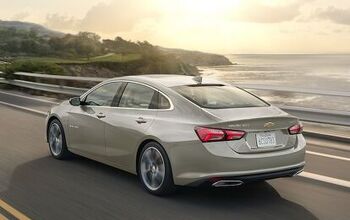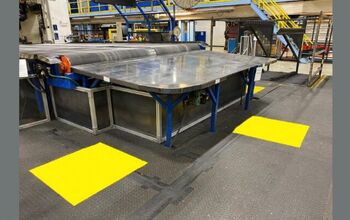Rare Rides Icons: The Cadillac Eldorado, Distinctly Luxurious (Part XXVI)

In our last Eldorado episode, we reviewed the interior changes made to the high-line Eldorado Brougham in its new-for-1959 guise. In the transition to more uniform product alignment with its Biarritz and Seville siblings, the Brougham lost almost all unique interior features. Its more formal pillarless hardtop roofline and smaller wings (a preview of 1960 Cadillacs) and a couple pieces of interior trim were what set the Brougham apart from other Cadillac sedans. However, the Brougham did have one new claim to fame: exotic Italian construction!
(Note: Above is the 1958 clay prototype for the Eldorado Brougham. The red Eldorado here is a 1959 Seville, while the black example is the revised 1960.)
While standard Eldorados were assembled by Fisher Body (1908-1984) and other upmarket Cadillacs (like the ‘57-’58 Brougham) used Fleetwood bodies, the 1959 Brougham was outsourced. Though it would still be hand-built, the craftsmen at Fleetwood in 1959 and 1960 had their hands full with other assembly line Cadillacs.
A low-volume solution was needed. Fortunately, General Motors had a good relationship with the folks at Pininfarina in Turin, Italy. The company had formerly built concept cars for Cadillac, and would later offer design work for other Cadillacs, and design and build the ill-fated Allanté. GM contracted with the coachbuilder to build the Eldorado Brougham. It’s sometimes misreported that Pininfarina designed the Brougham’s exterior, but that was not so. The finalized design was handed to Turin by Chuck Jordan and Bill Mitchell.
Cadillac shipped bare C-body chassis to the port of Savona, Italy, where they were transported 87 miles to the Pininfarina factory. Not likely an easy drive at the time, as the A6 Autostrada was not completed until 1960. Pininfarina fitted the body and interior of the Eldorado Brougham, then shipped the completed sedans back to Savona.
The cars returned to Detroit by boat and were then delivered to the Fleetwood shop, where they were fitted with final details including a Body by Fleetwood sill plate. It remains unclear how much finalization work was carried out at Fleetwood. Unfortunately, customers ended up envious of the owners of the hand-built Fleetwood ‘57 and ‘58 Broughams.
Pininfarina’s build quality was not up to the standard established by the previous generation Eldorado Brougham. It turned out the artisans in Turin were rather sloppy with their seam and joint work, and used lead filler for seams and in a lot of places to achieve an even fit and finish. It’s suggested around the Internet that the Brougham had around 100 pounds of lead filler in its body. This lack of quality was apparent to customers, who expected the same high standard found in the previous Eldorado Brougham.
Because the Eldorado Brougham debuted with 1960 styling in 1959, it was the rest of the brand which caught up to it the following year. The 1959 Eldorad’s extreme wings and bulbous front bumper were distilled the following year into a more 60s-ready essence. Beginning with the front end, most notable was the simplification of the grille area.
No longer bisected by a thick chrome strip, the Eldorado Seville and Biarritz wore a one-piece grille of the thinner vaned style found in the 1959 Brougham. Chrome strips across the awnings over the headlamps appeared, but the former chrome trim that flowed from the corner markers down to the headlamps were removed. Grille detailing extended around the front corners as the previous year.
The bumper underneath the revised grille looked simpler than in 1959; the shape of its chrome was generally more horizontal. Gone was the rounded metal to either side of the license plate, and in its place was a smooth surface. The license plate holder moved lower than in 1959, and was tucked under the front end to be less conspicuous.
Quad ovoid shapes that contained driving and indicator lamps took on a quadratic appearance instead, and were more inset within the bumper. Bumper detailing was lessened considerably, and as it wrapped around to the wheel it lost 1959’s ribbed detailing. At the upper corner of the fender, ELDORADO script was relocated to be more prominent than the prior year.
As expected for a refresh, the window and roof line remained the same as in 1959. Body side revisions included the lower body chrome panel, which spawned an additional thin chrome strip. The strip ran along the body from the front wheel arch, parallel to the lower chrome cladding.
It maintained a couple inches of separation so paint was visible between the two, and wrapped around the rear end. Continuing up and along the rear fender, the trim thinned and terminated at the A-pillar. It was a more delicate treatment than the 1959 model Eldorado, and made a big difference to the side profile.
Fins were halved in their height and greatly simplified in 1960. Bullet or gunsight detailing were gone, replaced with vertical integrated lamps from the Brougham. Beneath revised fins were rear fenders that were taller than the prior year, with more vertical surface area. The design was more squared off as well, and created a more substantial looking rear ¾ view.
Circular tail lamp housings of 1959 became larger ovals in 1960, and contained a new rear lamp assembly. Any V-shaped detailing was gone, and replaced by two circular pods mounted inside the oval perimeter. The top pod held a reversing lamp and brake lamp, while the lower was a dedicated brake lamp.
Eldorado script was relocated onto the trunk lid in larger block lettering, and the oval chrome trim above the bumper was removed. In its place was a simpler chrome strip above the trunk. Below that trim and between the rear lamps was a simplified grille detail to match the front end. The rear bumper was simplified like the front, and presented a more uniform flat surface devoid of any scalloping.
As intended the overall revisions to the Eldorado made it look more streamlined. The design had greater use of flat and smooth surfaces, and looked more restrained in general. The 1959 models proved to be the height of decadence and fins at Cadillac, and the brand would then ease off into a simpler, Mitchell-approved design era.
As we close out the third generation Eldorado in our next entry, we’ll discuss pricing and sales figures. Eldorado would thereafter enter a time of decline, and be relegated to a trim level. Eldorado’s glory days faded away, until a few years later when the personal luxury coupe market (and hot new competition) took off at the end of the Sixties.
Become a TTAC insider. Get the latest news, features, TTAC takes, and everything else that gets to the truth about cars first by subscribing to our newsletter.

Interested in lots of cars and their various historical contexts. Started writing articles for TTAC in late 2016, when my first posts were QOTDs. From there I started a few new series like Rare Rides, Buy/Drive/Burn, Abandoned History, and most recently Rare Rides Icons. Operating from a home base in Cincinnati, Ohio, a relative auto journalist dead zone. Many of my articles are prompted by something I'll see on social media that sparks my interest and causes me to research. Finding articles and information from the early days of the internet and beyond that covers the little details lost to time: trim packages, color and wheel choices, interior fabrics. Beyond those, I'm fascinated by automotive industry experiments, both failures and successes. Lately I've taken an interest in AI, and generating "what if" type images for car models long dead. Reincarnating a modern Toyota Paseo, Lincoln Mark IX, or Isuzu Trooper through a text prompt is fun. Fun to post them on Twitter too, and watch people overreact. To that end, the social media I use most is Twitter, @CoreyLewis86. I also contribute pieces for Forbes Wheels and Forbes Home.
More by Corey Lewis
Latest Car Reviews
Read moreLatest Product Reviews
Read moreRecent Comments
- Mike Some Evs are hitting their 3 year lease residual values in 6 months.
- Tassos Jong-iL I am just here for the beer! (did I say it right?)
- El scotto Tim, to be tactful I think a great many of us would like a transcript of TTAC's podcast. 90 minutes is just too long for most of us to listen. -evil El Scotto kicking in- The blog at best provides amusement, 90 minutes is just too much. Way too much.
- TooManyCars VoGhost; I was referring more to the Canadian context, but the same graft is occurring in the US of A and Europe. Political affiliation appears to be irrelevant.
- The Oracle Going to see a lot of corporations migrating out of Delaware as the state of incorporation. Musk sets trends, he doesn’t follow them.












































Comments
Join the conversation
Best part of this website is the history series.
When they assembled those in Italy, the grill was in Tuscany while the fins were in Calabria.